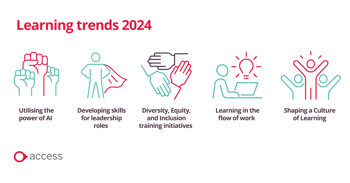5 Learning and development trends 2024
Learning and Development has seen a big change in recent years – the rise in artificial intelligence has caused a stir across all sectors and shown how technology can impact the way people carry out their roles.
We have enlisted some expert insight from Peter Freeth, consultant and Bookboon Learning author, to discuss the impact five emerging trends in learning and development will have on the L&D landscape going forward.
Learning trends in 2024

1. Utilising the power of AI
According to research carried out by Gov.uk, around one in six organisations have embraced at least one AI technology, showing that Artificial Intelligence and the role of technology in general has a huge part to play in the L&D space going forward. Organisations are looking at ways AI technologies can help with making digital learning more robust and streamlined, including:
- Creating personalised learning journeys
- Reducing time spent on administrative tasks
- Providing real-time feedback for assessments
If we think back to the late 90s, the amount of information available on the internet was growing at an incredible rate and the problem with accessing it became finding it. From the early search engines, Google emerged as the clear leader because of its smart indexing algorithms which made it easier for users to search in natural language and find exactly what they needed.
The advent of natural language AI models has taken this further, enabling people to interact with an enormous repository of human knowledge as if asking a question of another person. AI can therefore automate many repetitive or low value tasks such as translating text to other languages or even reformatting learning content to meet the needs of different learners
While there is still ways to go for AI automation, the surge in its reliance and the way it has been utilised in the past 12 months paired with the recognition of the L&D opportunities it brings suggests this is only the beginning.
Developing skills for leadership roles

2. Developing skills for leadership roles
The importance of strong leadership has never been more pronounced and this became even more present throughout 2024. Notably, the most recent LinkedIn Learning Report underscores this emphasis, revealing the top three training priorities for managers:
- Leadership and management skills
- Role-specific digital upskilling and digital transformation
- Supporting employee career development
These findings are really no surprise: developing staff for leadership roles and presenting them with opportunities that will advance their skillset will lead to job satisfaction, with the same report confirming that employees’ top motivation to learn is progression toward career goals. The feeling of belonging within an organisation will also increase employee retention and create a more resilient and flexible leadership team.
When looking to develop leadership skills within your organisation, you should consider undertaking the following activities:
Skills gap analysis:
Skills gap analysis is a crucial process in identifying the disparity between the skills that employees currently possess and the skills required for effective job performance, particularly in leadership roles. This analysis involves assessing the skills and competencies needed for a particular position and comparing them with the skills possessed by the employees.
With this understanding, organisations can tailor targeted training to bridge identified skill gaps, fostering individual development plans and measurable outcomes. The analysis contributes to succession planning by identifying potential leaders and enhances employee engagement through clear career paths.
Performance measuring metrics:
Performance measuring metrics are tools used to track, maintain, and improve how well an employee is doing within their role. It can include activities such evaluations, setting goals, providing training, and continuous development. Some organisations choose to utilise performance management software to align performance with business goals.
By measuring both performance and the employee’s enjoyment of a role, a much more accurate picture is created of each employee’s strengths. Instead of using expensive, convoluted tests to predict if someone can do a job, let them do it and see what happens. It might sound simplistic but the reality is that many corporate talent teams devote significant resources to finding the most complicated ways to achieve something that is actually straightforward.
Targeted management and leadership training
When courses are offered which focus on essential leadership and management skills, it can help to bridge any skill gaps and foster professional growth. This can include a mix of hard and soft skills which can help to progress someone to a leadership position.
Our range our Workplace skills and development eLearning include:
Using these methods will help to identify and foster leadership skills, ensuring that leaders within your organisation are striving for more. By giving them the right opportunities and support they need, they will be able to navigate the challenges of an ever-evolving professional landscape with success.
Diversity, Equity, and Inclusion training initiatives

3. Diversity, Equity and Inclusion training initiatives
It goes without saying that fairness, equality and inclusion should be woven into the fabric of your organisation’s values. However, you need to ensure you are also holding your learning materials to the same standard. By doing so, it will ensure everybody can access and utilise learning in a way that suits them most.
Consider the following points:
- Is the navigation of your training easy to follow?
- Can the text be enlarged and is the font legible?
- Has the content been tested for accessibility?
Utilising technology to ensure these needs are met will give your employees the reassurance that the organisation they work for is taking DEI seriously. When you provide inclusive and accessible learning content, you are empowering all employees by removing any barriers they may be facing.
One of the comments which anyone is sure to hear during DEI training is, “I treat everyone equally, I don’t see difference, therefore I already support diversity” Often, the people who are in majority groups of any kind fail to recognise the importance of diversity because they have little to no first hand experience of being in a minority group. On the other hand everyone, at some point in their lives, will have felt excluded, left out or rejected.
Although these might seem like unpleasant experiences, they are crucial in building an understanding of what others might experience. Empathy is a universal human trait, yet it is one which we can easily switch off when acknowledging the pain of others becomes uncomfortable or inconvenient. EDI initiatives which build on empathy, shared experiences and collaborative connections are ultimately built upon a foundation of what makes us human and are therefore more likely to be sustainably effective.
Invest in the future of your organisation with Diversity, Equity and Inclusion training
4. Learning in the flow of work
Another of the future trends in learning and development is integrating learning seamlessly into the flow of work. By embedding learning opportunities with employee’s daily tasks, they are more likely to seek out different types of training and encourages a more hands-on approach to learning.
Learning should be:
- Available on demand
- Offered in bitesize chunks
- Undisruptive to a workflow
By embodying these principles, organisations create an environment where learning becomes a natural aspect of an employee's professional journey. To facilitate this, organisations can use a mobile app connected to a Learning Management System that delivers easily digestible content.
This makes it convenient for users to undertake training during short blocks of free time. Such an approach not only enhances the effectiveness of training but also promotes a culture of continuous improvement, where knowledge acquisition aligns seamlessly with the demands of the modern workplace.
A common mistake made in corporate learning is to think that learning only takes places in a classroom in the presence of a trainer. In practice, people are learning constantly because learning is a basic function of the brain.
The question is, what are they learning, and more importantly, how are they sharing that knowledge? Managers can easily focus this innate ability by setting intentions for learning and then creating a forum for sharing learning.
Learning in the flow of work

5. Shaping a Culture of Learning
An L&D trend we touched upon in our 2023 predictions was the value of a robust learning culture, and this has become even more apparent in recent months. A culture of learning is not just a corporate buzzword; it's a daily process. Beyond merely presenting learning opportunities, organisations must actively support employees on their journey towards lifelong learning.
Your organisation should encourage:
- Pursuing further learning opportunities beyond training they may view as a box-ticking exercise
- Utilising a learning management platform such as an LMS which provides insightful data to measure learning uptake
- Fostering a collaborative knowledge-sharing environment
- The freedom to undertake learning on a self-guided basis
Shaping a learning culture cannot be a ‘top down’ approach, led by senior managers and L&D teams. It has to be a daily line management process. Supporting managers to put the focus onto learning and innovation rather than conformity and process can be challenging, especially when individual targets ultimately feed up into organisational metrics and the demands of external stakeholders.
A brave manager will create an insulating layer between data that is reported externally and internal data which supports real time learning, fast feedback and continuous improvement.
Shaping a learning culture

Learning trends 2024: a summary
As we reflect on the year 2024, five key L&D trends emerge, each playing a pivotal role in shaping the future of professional growth:
- Utilising the power of AI
- Developing skills for leadership roles
- Diversity, Equity, and Inclusion training initiatives
- Learning in the flow of work
- Shaping a culture of learning
Learning and Development is undergoing a transformative shift, marked by the alignment of innovation and strategy. To adapt to these changes, L&D teams must prioritise emerging technologies, be more strategic and embrace a content first approach.
Staying informed of the latest industry trends and anticipating future skills are also key to keeping up with the pace of change within the L&D industry.
Explore our Digital Learning platform today!
There are many ways to find out more about Access Learning and how it can transform learning, development and compliance in your business.
Speak to an expert
Chat with one of our learning experts and find out how Access Learning can be tailored to meet the needs of your business, regardless of size.

View our eLearning library
Explore our extensive eLearning library, written by experts and designed to enhance the learning requirements of your organisation.
